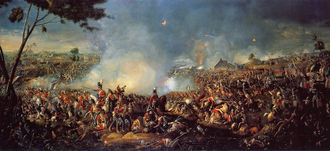User:Chasun: Difference between revisions
Jump to navigation
Jump to search
The ©rusader (talk | contribs) m (Edit in categories) |
(Replaced content with "{{WIP}} {{Region icon Aurorum}} {{Infobox military conflict | conflict = Alhstead Wars | image = 330px | caption = The Ba...") Tag: Replaced |
||
| Line 1: | Line 1: | ||
{{WIP}} | {{WIP}} | ||
{{ | {{Region icon Aurorum}} | ||
{{Infobox | {{Infobox military conflict | ||
| | | conflict = Alhstead Wars | ||
| image = [[File:Battle_of_Waterloo_1815.PNG|330px]] | |||
| caption = The Battle of Auserburg (7-8 May 1790) | |||
| | | date = {{start date|df=yes|1832|08|27}} – {{End date|df=yes|1841|01|02}} ({{Age in years, months and days|1832|08|27|1841|01|02}}) | ||
| place = [[Berea]], [[North Sea (Aurorum)|North Sea]], [[Karsk Sea]], [[White Sea (Aurorum)|White Sea]], [[Lake Sigismund]], Caphtoran Ocean | |||
| | | result = Moderate Cuthish victory (''Restoration'') | ||
| | * Re-emergence of the [[Second Cuthish Empire|Cuthish Empire]] as a Berean {{wp|great power}} | ||
| | * Consolidation of the [[House of Alhstead|Alhstead Haltboruh]] monarchy | ||
| | * Widespread rise of {{wp|liberalism}}, {{wp|republicanism}} and {{wp|nationalism}} in Berea | ||
| | * Offset of the Berean balance of powers | ||
| | * Intensified efforts and involvement of [[Mascyllary Kingdom|Mascylla]] and [[Lavaria]] as great powers | ||
| | * [[Mascyllary Revolution of 1847]] | ||
| | | territory = | ||
| combatant1 = {{flagicon image|MascyllaFlagIII.png}} [[Mascyllary Kingdom]]<br>{{flag|Dulebian Empire}}<br>{{flag|Norden}}<br>[[Kingdom of Waldrich|Waldrich]]<br>{{flag|Lilienburg}} | |||
| combatant2 = {{flagicon image|Flag_of_Cuthland.png}} [[Second Cuthish Empire|Cuthish Empire]] | |||
| commander1 = {{flagicon image|Aldia_flag.png}} [[Monarchy of Mascylla|Lucas I]]<br>{{flagicon image|Aldia_flag.png}} [[Prime Minister of Mascylla|William of Stenreck]]<br> {{flagicon image|Aldia_flag.png}} Helmuth of Mohrnau<br> {{flagicon image|Aldia_flag.png}} George of Schüldte<br>{{flagicon image|Flag of the Kingdom of Welsbach.png}} Charles Frederick II<br>William of Oppenburg | |||
| commander2 = {{flagicon image|FlagAdwhin.png}} Theodore III<br>{{flagicon image|FlagAdwhin.png}} Christopher of Wälsberg<br>{{flagicon image|FlagAdwhin.png}} Louis of Bernestedt<br>{{flagicon image|Flag_of_Germany_(3-2_aspect_ratio).svg}} Erich Joseph Kleitzer<br>{{flagicon image|Flag_of_Bavaria_(striped).svg}} Crown Prince Leopold | |||
| | | strength1 = '''666,370''' | ||
* {{flagicon image|Aldia_flag.png}} 390,870 | |||
* {{flagicon image|Elbgau_Confederacy_flag.png}} 275,500 | |||
| strength2 = '''556,700''' | |||
* {{flagicon image|FlagAdwhin.png}} 408,100 | |||
| | * {{flagicon image|Flag_of_Bavaria_(striped).svg}} 90,000 | ||
* {{flagicon image|Flag_of_Germany_(3-2_aspect_ratio).svg}} 58,600 | |||
| | | casualties1 = '''61,205''' | ||
* {{flagicon image|Aldia_flag.png}} 44,746 | |||
| | * {{flagicon image|Elbgau_Confederacy_flag.png}} 16,459 | ||
| casualties2 = '''102,320''' | |||
* {{flagicon image|FlagAdwhin.png}} 68,960 | |||
* {{flagicon image|Flag_of_Bavaria_(striped).svg}} 20,864 | |||
* {{flagicon image|Flag_of_Germany_(3-2_aspect_ratio).svg}} 12,496 | |||
| | |||
| | |||
| | |||
| | |||
| | |||
| | |||
| | |||
| | |||
| | |||
| | |||
| | |||
| | |||
| | |||
| | |||
| | |||
| | |||
| | |||
| | |||
| | |||
| | |||
| | |||
| | |||
| | |||
| | |||
| | |||
| | |||
}} | }} | ||
Revision as of 17:48, 25 September 2021
This article is incomplete because it is pending further input from participants, or it is a work-in-progress by one author. Please comment on this article's talk page to share your input, comments and questions. Note: To contribute to this article, you may need to seek help from the author(s) of this page. |
| Alhstead Wars | |||||||
|---|---|---|---|---|---|---|---|
 The Battle of Auserburg (7-8 May 1790) | |||||||
| |||||||
| Belligerents | |||||||
|
Waldrich |
| ||||||
| Commanders and leaders | |||||||
|
William of Oppenburg |
| ||||||
| Strength | |||||||
|
666,370
|
556,700
| ||||||
| Casualties and losses | |||||||
|
61,205
|
102,320
| ||||||